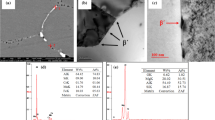Abstract
The influences of applied magnetic field on the corrosion behavior of Al–3.0 wt%Mg alloy in 3.5 wt% NaCl solution were investigated by electrochemical measurements, scanning electron microscopy (SEM) and energy-dispersive spectroscopy (EDS). Stochastic analysis was applied to investigate the influences of applied magnetic field. The results indicate that the application of horizontal magnetic field of 0.4 T would increase the pitting corrosion potential (E pit), decrease the corrosion current density (i corr), prolong the pit initiation time, slow down the pit generation rate and inhibit the growth of pitting of the tested alloys in 3.5 wt% NaCl solution. The applied magnetic field would also change the mechanism of pit initiation of Al–3.0 wt%Mg alloy from A3 model (without magnetic field) to A3 + A4 model (with magnetic field). The intermediate product Al +(ad) is the paramagnetic ion that would be influenced by magnetic field sensitively.










Similar content being viewed by others
References
Chung DDL. Electromagnetic interference shielding effectiveness of carbon materials. Carbon. 2001;39(2):279.
Yang SY, Lozano K, Lomel A, Jones R. Electromagnetic interference shielding effectiveness of carbon nanofiber/LCP composites. Compos Part A Appl Sci. 2005;36(5):691.
Kim BR, Lee HK, Park SH. Electromagnetic interference shielding characteristics and shielding effectiveness of polyaniline-coated films. Thin Solid Films. 2011;519(11):3492.
Cui ZH, Zhang C, Jing Y, Liu H, Jia YZ. Influence of alloying elements on corrosion resistance of aluminum alloy foils. Chin J Rare Met. 2014;38(2):176.
Lu Z, Huang C, Huang D, Yang W. Effects of a magnetic field on the anodic dissolution, passivation and transpassivation behaviour of iron in weakly alkaline solutions with or without halides. Corros Sci. 2006;48(10):3049.
Lu Z, Chen JM. Magnetic field effects on anodic polarisation behaviour of iron in neutral aqueous solutions. Br Corros J. 2000;35(3):224.
Sueptitz R, Koza J, Uhlemann M, Gebert A, Schulz L. Magnetic field effect on the anodic behaviour of a ferromagnetic electrode in acidic solutions. Electrochim Acta. 2009;54(8):2229.
Tang YC, Davenport AJ. Magnetic field effects on the corrosion of artificial pit electrodes and thin films. J Electrochem Soc. 2007;154(7):362.
Lu Z, Yang W. In situ monitoring the effects of a magnetic field on the opencircuit corrosion states of iron in acidic and neutral solutions. Corros Sci. 2008;50(2):510.
Su X, Xu GM, Jiang DH. Distribution uniformity of added elements in twin-roll cast Al–Zn–Mg–Cu alloy by multi-electromagnetic fields. Rare Met. 2015;34(8):546.
Hu J, Dong CF, Li XG, Xiao K. Effects of applied magnetic field on corrosion of beryllium copper in NaCl solution. J Mater Sci Technol. 2010;26(4):355.
Guo B, Zhang P, Jin YP, Cheng SK. Effect of alternating magnetic field on the corrosion rate and corrosion products of copper. Rare Met. 2008;27(3):324.
Shinohara K, Aogaki R. Magnetic field effect on copper corrosion in nitric acid. Electrochemistry. 1999;67(2):126.
Chiba A, Ogawa T. Effects of magnetic field direaction on the dissolution of copper, zinc, and brass in nitric acid. Corros Eng. 1988;34(4):455.
Liu L, Li Y, Wang FH. Influence of nanocrystallization on pitting corrosion behavior of an austenitic stainless steel by stochastic approach and in situ AFM analysis. Electrochim Acta. 2010;55(7):2430.
Zhang T, Yang YG, Shao YW, Meng GZ, Wang FH. A stochastic analysis of the effect of hydrostatic pressure on the pit corrosion of Fe–20Cr alloy. Electrochim Acta. 2009;54(15):3915.
Shibata T, Takeyama T. Stochastic theory of pitting corrosion. Corrosion. 1997;33(7):243.
Shibata T, Ameer MAM. Stochastic processes of pit generation on zirconium with an anodic oxide film. Corros Sci. 1992;33(10):738.
Fujimoto S, Shibata T, Minamida M, Udaka S. A statistical evaluation of crevice corrosion on type 304 stainless steel. Corros Sci. 1994;36(9):1575.
Tang YM, Zuo Y, Zhao H. The current fluctuations and accumulated pitting damage of mild steel in NaNO2–NaCl solution. Appl Surf Sci. 2005;243(1–4):82.
Shao M, Fu Y, Hu RG, Lin CJ. A study on pitting corrosion of aluminum alloy 2024-T3 by scanning microreference electrode technique. Mater Sci Eng A. 2003;344(1–2):323.
Arrabal R, Mingo B, Pardo A, Mohedano M, Matykina E, Rodriguez I. Pitting corrosion of rheocast A356 aluminum alloy in 3.5 wt% NaCl solution. Corros Sci. 2013;73:342.
Despić AR. Electrochemical properties of aluminum alloys containing indium, gallium and thallium. J Appl Electrochem. 1976;6(6):527.
Ford FP, Burstein GT, Hoar TP. Bare surface reaction rates and their relation to environment controlled cracking of aluminum alloys. J Electrochem Soc. 1980;127(6):1325.
O’Brien RN, Santhanam KSV. Electrochemical hydrodynamics in magnetic fields with laser interferometry: influence of paramagnetic ions. J Appl Electrochem. 1990;20(3):427.
Hinds G, Coey JMD, Lyons MEG. Influence of magnetic forces on electrochemical mass transport. Electrochem Commun. 2001;3(5):215.
Waskaas M, Kharkats YI. Effect of magnetic fields on convection in solutions containing paramagnetic ions. J Electroanal Chem. 2001;502(1–2):51.
Acknowledgments
This study was financially supported by the National Natural Science Foundation of China (No. 51379070) and the Fundamental Research Funds for the Central Universities (No. 2014B31714).
Author information
Authors and Affiliations
Corresponding author
Rights and permissions
About this article
Cite this article
Zhang, X., Wang, ZH., Zhou, ZH. et al. Corrosion behavior of Al–3.0 wt%Mg alloy in NaCl solution under magnetic field. Rare Met. 36, 627–634 (2017). https://doi.org/10.1007/s12598-016-0785-5
Received:
Revised:
Accepted:
Published:
Issue Date:
DOI: https://doi.org/10.1007/s12598-016-0785-5




